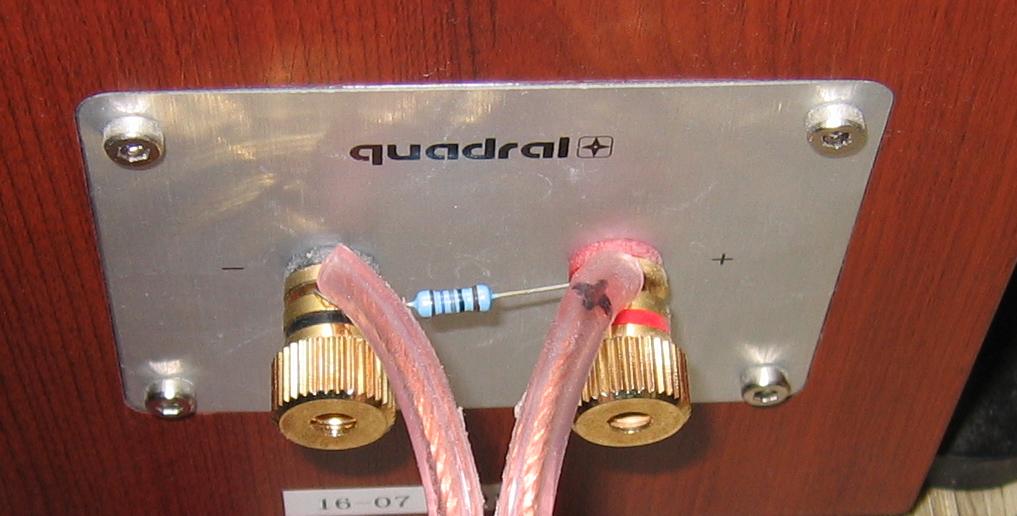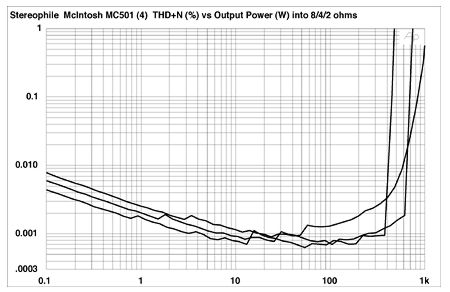
A common practice, at least to some of us.
aha...a resistive zobel
jn
That's it. And it works. Resistance is close to cable HF wave impedance.
I can, pavel I hope you don't mind..
When the load "unloads", or goes above the cable's characteristic impedance, the cable will look like a capacitor to the amp. This resistor guarantees that no matter what the load does, the termination at that end will never be above the cable's impedance, so the amp will always see either inductance, or resistance.
For rf, it guarantees that there will not be cable resonances as a consequence of reflections.
The caveat is, if the cable is a low z type, that resistor would be too low a value, and it would consume power. When the cable is very low z, you'll have to put a cap in there as well to protect the resistor against lf power.
jn
How to calculate the cap value?
About the resistor value 100-300 ohms don't change if the loudspeaker have 4 ohms?
TIA & sorry in advance for these newbie wuestions.
Last edited:
This is part of the story, most of the expensive speakers I've heard sounded absolutely dreadful as soon as you gave them a bit of stick, not because there's a problem with the speakers but because the driving electronics started to fall to pieces, so to speak, once they were asked the question. This, for example, is where the Bryston I heard 'knew' what it was doing, increasing the volume merely increased the subjective intensity of the sound, it didn't degenerate into the typical 'loud hifi' sound.
The other part of the story is that the quality is there over the full dynamic range of the material - otherwise increasing the volume then reveals how mangled, or absent, the low level detail within the recording is, caused by deficiencies in the playback.
The brystons were very powerful , the others had the same ..?
Yes one time (the worst actually) it was about $100,000 worth of Cello's best including I guess what would be their version of the BT.In fact it must have been more $$$ there were two massive ML amps, maybe it was just ML's vanity jazz recordings.
This highend business is so easy to make fun of.
EDIT - This was a store BTW, Bob Adams asked me along because ADI wanted a serious listening room installed and asked the local store to demo us "the best".
I can understand where you are coming from very few shops or shows have good sound, sometimes at shows its just the din in the room causing an issue. Yesterday we were treated to 90k of mcintosh best , speakers amp etc, those with me were tearing the system down , i thought otherwise , IMO poor placement in a non treated room were mostly the issue, aside i did not believe , it would have achieved the level of sound we have become accustomed to , but it had the potential to sound much better and that would have made the system good ..
Now , the real issue , has the dollar shrank so much that it takes 90k to get "good sound " looking around i was astonished at the prices on "good gear" most speakers seem to be in the 20-60k range ...
Ps: I will agree on the sound of Thiels , in their defense they are very finicky to setup and frontend material ...
Last edited:
I am always disappointed when people show their 'worst' sounding examples, rather than the 'best' sounding examples. Mac is not real hi end, it is based on good looks, kind of like B&O.
Cello was another disappointment, except for the really good equalizer designed by Dick Burwen. Mark Levinson surely fell for his own hype, and decided that he could get away with selling almost 'anything'.
Cello was another disappointment, except for the really good equalizer designed by Dick Burwen. Mark Levinson surely fell for his own hype, and decided that he could get away with selling almost 'anything'.
Mac is not real hi end, it is based on good looks, kind of like B&O.
Uhhh.... right.
McIntosh MC501 monoblock power amplifier Measurements | Stereophile.com
EVERYONE, please look at figure 8 at the xover distortion.
Indeed, look at that level! And how it shows up in the harmonic and intemod analysis! (480W into 4 ohms, 0.00075%, how dreadful! )
I guess this is part of your oft-stated efforts to not criticize your competitors.
Now , the real issue , has the dollar shrank so much that it takes 90k to get "good sound " looking around i was astonished at the prices on "good gear" most speakers seem to be in the 20-60k range ...
I think dollar shrinkage is overstated, the price of luxury goods involves a lot of complex factors. That aside there have been many speaker building threads here with a lot of commited participants who have made themselves quite happy for a lot less money. So define most, that's more than all but a few here would spend and JC has some $20K+ ones that need by some folks estimation a mod out of the box to be "listenable". It's hard to take this kind of business seriously.
EDIT - As an example some luxury food items have outpaced others by more than an order of magnitude, in some cases by 50x in 20yr. solely on the fashion aspect.
Last edited:
AH, the joy of lots of negative feedback. '-)
Is that a pun? A sarcastic one to boot.
I think dollar shrinkage is overstated, the price of luxury goods involves a lot of complex factors. That aside there have been many speaker building threads here with a lot of commited participants who have made themselves quite happy for a lot less money. So define most, that's more than all but a few here would spend and JC has some $20K+ ones that need by some folks estimation a mod out of the box to be "listenable". It's hard to take this kind of business seriously.
EDIT - As an example some luxury food items have outpaced others by more than an order of magnitude, in some cases by 50x in 20yr. solely on the fashion aspect.
Granted, Hi-end anything is highend and the prices are less reflective , regardless Inflation is rampant Scott , worst is the stagflation we are going into , items built to old high standards are more reflective of where the true value of the dollar stands today , the affordable stuff is from China , where the poor out numbers the whole population of No & So America, when this cheap labor diminishes or quality is built to old standards , prices will be reflective of such.
As to Curl's speakers , i would love to hear what these big eared pundits are talking about ..
Last edited:
The same, what ...? From my POV the Bryston was the amp that was working correctly, the others weren't.The brystons were very powerful , the others had the same ..?
Even before I made my major step forward in getting good sound I knew the amplifier power gradings were a nonsense - a certain brand had a 50W, a 75, a 100, and a 150W model. The only relevance this had to anything was that the power supply had to have a bit more grunt to it on the 'bigger' models, so that technically it could achieve the higher 'rating'. And the power supply being a bit meatier was the sole reason that the amp was 'more impressive' in normal listening ...
Smartest thing to do, IMO. An audio amplifier is not a piece of industrial machinery, to do a "Look how big my bits are!!" are, on demand. In the ideal it should be continually self optimising, to achieve the highest sound quality - and wearing out the components by cooking them for extended periods is not the brightest thing ...Notice the Mac 'shut itself off after 20 mins at 30 watts rms, fenky at best ...
Except that the lowest THD is reached shortly before amp goes into clippingIndeed, look at that level! And how it shows up in the harmonic and intemod analysis! (480W into 4 ohms, 0.00075%, how dreadful! )

I very much prefer this kind of amp behaviour:
An externally hosted image should be here but it was not working when we last tested it.
It is interesting to read the MAC performance curves in respect to audio 'quality'. Any other comments on the way this amp was designed from the data given?
Shuts off with standard preconditioning? Seems a long way from the days when Davey O'Brien would gleefully toss slightly weak Genalex KT88's into the trash to bring an old Mc amplifier brought to one of his clinics up to snuff (and for free.)
And your point about crossover distortion is not amiss: -93dB 3rd harmonic from a +25dBW output signal is -68dB ref 1 watt, a reasonably typical listening level with typical speakers of say 88dB SPL/1W/1M.
If they really cared about correlating measurements with sound, they would test the amplifiers at 0dBW or maybe +10dBW. But distortion of -68dB would look bad (cause it is.)
Thanks, as always,
Chris
- Status
- Not open for further replies.
- Home
- Member Areas
- The Lounge
- John Curl's Blowtorch preamplifier part II